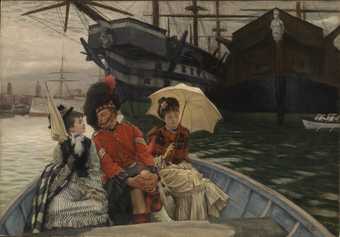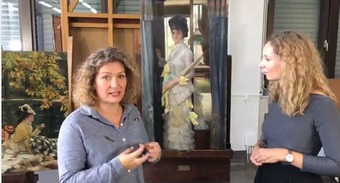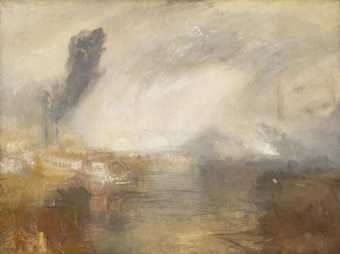INTRODUCTION

James Tissot The Ball on Shipboard c.1874 Tate Presented by the Trustees of the Chantrey Bequest 1937
‘THE TERRIBLE YEAR’: THE FRANCO-PRUSSIAN WAR AND PARIS COMMUNE
On 19 July 1870, France declared war on Prussia, confident in the superiority of its army and new weaponry. In just six weeks, each side lost 100,000 men, and Napoleon III was deposed. After the fall of the Second Empire, the fight went on, culminating in the three-month Siege of Paris, during which food was in such short supply that people resorted to eating pets, rats, and zoo animals to survive. Unwilling to accept defeat and the humiliating terms of the Treaty of Frankfurt, a radical popular uprising, the Paris Commune, ensued. Some eight weeks later in May 1871, during Bloody Week (‘la semaine sanglante’), it was crushed by the French government. Around 20,000 people, including women and children, died, mostly through reprisals. Many monuments were destroyed, either in warfare, or when Communards set fire to seats of power.
This opening section shows the devastation from which French artists fled. A selection of very personal works highlights the impact of the war and Paris Commune on artists who experienced them. James Tissot stayed in Paris throughout the events as a stretcher-bearer in the National Guard, and witnessed executions as the Commune fell.
ROOM ONE
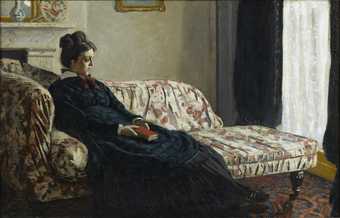
Claude Monet Meditation, Mrs Monet Sitting on a Sofa 1871 musée d'Orsay, Paris, France © photo musée d'Orsay / rmn
THE FUTURE IMPRESSIONISTS’ LONDON CIRCLE
London, with its thriving art market, was an attractive destination for refugee artists. Charles-François Daubigny had already come twice to explore its potential in the 1860s and sought refuge here in autumn 1870. He met with the art dealer Paul Durand-Ruel, who had moved his family and stock to safety in London a month earlier, settled in Knightsbridge and opened a gallery on New Bond Street.
While painting by the Thames, Daubigny also encountered the impoverished twenty-nine-year-old Claude Monet, who had crossed the Channel to avoid conscription. He urged Durand-Ruel to buy Monet’s work and a long and fruitful partnership between the dealer, Monet and his fellow refugee Camille Pissarro began. The forty-year old Pissarro, whose house in Louveciennes had been used as stables by the Prussians, joined his mother and other relations in south London in December.
Alfred Sisley’s home in Bougival was also destroyed by the Prussians, and his family ruined by the conflict. He came to London in 1874 to salvage his financial situation, sponsored by a patron, opera singer Jean-Baptiste Faure, Durand-Ruel’s friend, client and neighbour.
ROOM TWO
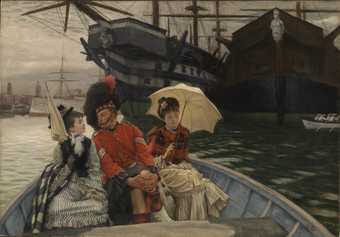
James Tissot Portsmouth Dockyard c.1877 Tate Bequeathed by Sir Hugh Walpole 1941
TISSOT AND HIGH SOCIETY
When the Franco-Prussian War broke out, James Tissot was enjoying considerable success in France. He owned a large house reflecting this status in what is now Avenue Foch in Paris, but France no longer offered him the same prospects and at the end of the ‘Terrible Year’ in 1871 he crossed the Channel.
Tissot first found shelter with Thomas Gibson Bowles, the editor of Vanity Fair for which he had produced caricatures since 1869. Bowles was a war correspondent during the Siege of Paris, which strengthened their bond. Thanks to him, Tissot was introduced into high society, and rapidly rose to success though English critics often implied that he was mocking British customs. His paintings are deliberately ambiguous and openended, characterised by a distanced point of view.
Tissot, like his friend Giuseppe de Nittis, became a member of the select and cosmopolitan Arts Club in Hanover Square. He bought a large house in St John’s Wood which he would share with his Irish lover Kathleen Newton, until her death from consumption in 1882. Tissot then abruptly returned to France.
ROOM THREE
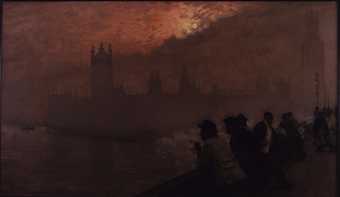
Giuseppe De Nittis Westminster 1878 Private Collection
LEGROS: AN ARTIST AT THE HEART OF THE FRENCH REFUGEE COMMUNITY
Alphonse Legros settled in London in 1863, encouraged by James Abbott McNeill Whistler. Whistler, Dante Gabriel Rossetti, Edward Burne-Jones and George Frederic Watts secured commissions for him and Legros succeeded Edward Poynter as Slade Professor of Fine Art in 1876. Perceived in France as a model of success, he became the main port of call for his refugee compatriots. Monet and Pissarro lunched with him, Durand-Ruel enlisted his help, and Tissot contacted him shortly after his arrival.
Legros was especially supportive of the sculptor Jules Dalou, a convicted Communard who developed a thriving career in Britain, with public, aristocratic and royal commissions. Both had studied at the Petite Ecole in Paris, as had the sculptor Edouard Lantéri, who, when he could no longer live off his art in Paris, came to England in 1872, where Dalou secured him a position as assistant to fellow-sculptor Joseph Boehm. Lantéri and Dalou, like Legros, gained influential positions as teachers and revolutionised the way in which modelling was taught in British art schools. They were also instrumental in introducing Rodin – another former student at the Petite Ecole – to British supporters at a time when recognition in France was slow in coming.
ROOM FOUR
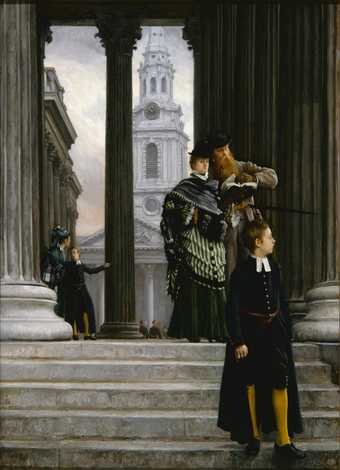
James Tissot London Visitors 1873 Milwaukee Art Museum, Layton Art Collection, Gift of Frederick Layton L1888.14
CARPEAUX IN LONDON
The celebrated sculptor of the Second Empire, Jean-Baptiste Carpeaux, arrived in London in March 1871, shortly before Napoleon III joined his wife and son at Camden Place, Chislehurst. The war damage to his studio in Auteuil, the fall of the Emperor, and the impending civil war were all motives for Carpeaux’s departure. He probably had hopes that the exiled Imperial family would still patronise him abroad, but the prospect of making forays into the art market in England was also attractive.
When in London, Carpeaux socialised with other refugees, the painter François Bonvin and his friend, painter and sculptor Jean-Léon Gérôme, as well as composer Charles Gounod, a permanent resident at Tavistock House, the home of the exuberant Georgina Weldon. Carpeaux found success with British collectors such as Lord Ashburton and especially with Henry James Turner, a young patron of Gérôme and Tissot.
Carpeaux stayed in London between March and December 1871, but the Prince Imperial, son of Napoleon III, commissioned him to make a bust of the deposed Emperor and he returned in 1872. The illness of the Emperor delayed the sittings, and Carpeaux visited again just after Napoleon III’s death in January 1873, when he remained for three months.
ROOM FIVE
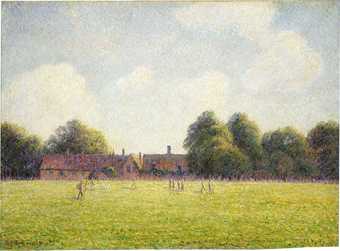
Camille Pissarro Hampton Court Green 1891 National Gallery of Art, Washington. Ailsa Mellon Bruce Collection
THROUGH OUTSIDERS’ EYES: BRITISH SPORTS, CROWDS AND PARKS
This and the following rooms demonstrate the originality that the impressionists and their friends brought to representations of London. They perceived their new environment with a distance that drove them to subjects which Victorian artists deemed too prosaic or treated differently. This room focuses on unexpected themes which fired their imagination. Beyond an engagement with the English landscape and cityscape, these reveal keen observation and a fascination for British customs and culture.
Regattas and rowing events, which formed an essential part of the English social calendar, were a more conspicuous display of class, costumes and codes than they were in France. French enthusiasm for British sports reflected a rising interest in their role in promoting fitness, a competitive spirit, and collective principles. Their worth to nation and empire was especially acknowledged after the humiliating Franco-Prussian war.
These artists were struck by the teaming crowds of the largest metropolis in the world. London parks were a major attraction as vast spaces of social interaction and freedom, compared to the smaller and tamer Parisian squares in which walking on the grass was usually forbidden.
ROOM SIX
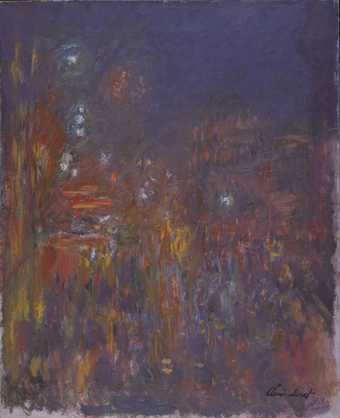
Claude Monet Leicester Square 1901 Jean and Suzanne Planque Foundation, on loan to musée Granet (inv. FJSP-998-116) Photo © Luc Chessex
THROUGH OUTSIDERS’ EYES: FOGS, THE THAMES, AND WESTMINSTER
The Thames and its atmospheric effects were key themes that were to occupy the artists included in this exhibition. Daubigny and Monet had already risen to the challenge of painting fog on the river during their exile and Monet criticised Victorian painters for painting London:
brick by brick … bricks they didn’t see, bricks they could not see. It’s the fog that gives London its marvellous breadth.
But it was left to another foreign painter, Whistler, to pursue this endeavour, and to be credited by Oscar Wilde with ‘the invention of fogs’.
This room considers the novelty with which outsiders tackled the Thames and the challenge of its fog, and how, in their work, the Palace of Westminster gradually emerged as a trope through which they competed with each other. It concludes with Pissarro’s first painting of central London and the river with Westminster in the centre, executed at a time when he knew that Monet was planning to paint a series on the Thames, the subject of the next room. Some of Pissarro’s children had settled in London and he considered a permanent move here himself.
ROOM SEVEN
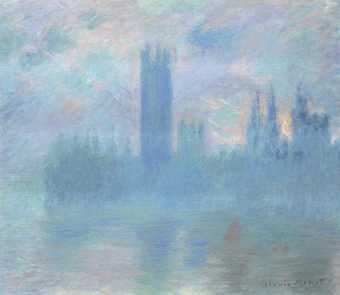
Claude Monet Houses of Parliament c.1900 Art Institute of Chicago (Chicago, USA)
MONET’S THAMES SERIES: EXPLORING SENSATIONS FROM THE PAST
Around his sixtieth birthday, Monet expressed a wish to explore earlier motifs ‘to sum up … impressions and sensations of the past’. He would
focus on the river, particularly at Westminster. For three consecutive winters, in 1899, 1900 and 1901, Monet stayed at the Savoy Hotel and dedicated himself to his Thames series, which in the end involved working simultaneously on almost a hundred canvases. Monet began with Charing Cross and Waterloo Bridge and only started on his last group of the Houses of Parliament in 1900, painting from a terrace in St Thomas’ Hospital. His struggle with the Thames’s atmospheric effects ended in 1901, when he fell ill and decided to return to France to finish the series.
Famous by then, he could afford to keep the canvases in his studio to work on them as a group. In 1904, the year of the Entente Cordiale, he finally delivered them to Durand-Ruel, who exhibited thirty-seven Views of the Thames at his gallery in Paris in what proved to be Monet’s most successful exhibition to date. He hoped to show his series in London ‘for his own personal satisfaction’, but other projects got in the way.
ROOM EIGHT
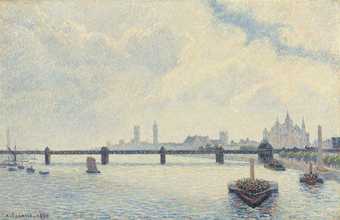
Camille Pissarro Charing Cross Bridge, London 1890 National Gallery of Art, Washington, Collection of Mr. and Mrs. Paul Mellon 1985.64.32
DERAIN AND THE THAMES: HOMAGE AND CHALLENGE
André Derain was only twenty-three when he visited Paul Durand-Ruel’s gallery to see Monet’s Views of the Thames. He wrote to the French painter Maurice de Vlaminck about the older artist, who by now was part of the establishment:
In spite of everything, I adore him. Wasn’t he right to render with his fugitive and durable colour, the natural impression which is no more than an impression, without lasting power, and did he not increase the character of this painting? As for myself, I’m looking for something different, something in nature which, on the contrary, is fixed, eternal, complex.
The rising art dealer Ambroise Vollard, who also saw Monet’s one-manshow, tried to emulate its success: he sent Derain to London in 1906 to paint the British capital. Thirty canvases resulted from this trip. This coda to the exhibition highlights how Derain paid homage to Monet by choosing the same motifs, such as Charing Cross Bridge, but also challenged him on the same ground, using his own radical expression. From 1871 onwards, Westminster and the Thames were
adopted by French artists as a challenging subject to be reinvented through new modes of expression, forever transforming the image of London.
The EY Exhibition: Impressionists in London, French Artists in Exile (1870 – 1904) is on at Tate Britain until 7 May 2018.

